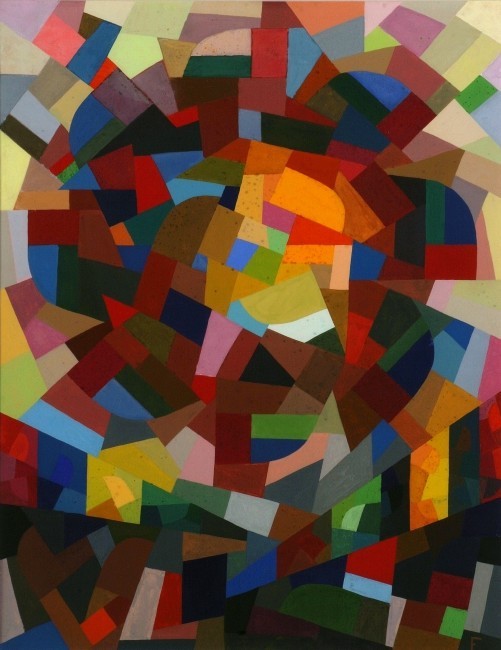L’art en guerre (Art at War), France 1938-1947
12 Oct 2012 - 17 Feb 2013

Rosace II, 1941
Gouache sur carton
Musée de Pontoise Donation Freundlich © Musées de Pontoise Otto Freundlich © Imec Images
12 October 2012 - 17 February 2013
This exhibition at the Musée d’Art Moderne de la Ville de Paris shows how deeply artists changed the form and content of art in France in the climate of threat and penury of the years 1938-47. Ten powerful sequences comprising almost 400 works by over a hundred artists are backed up by film and other documentary material.
By way of introduction, the International Exhibition of Surrealism of January 1938 seems premonitory in a context of looming danger André Breton and Marcel Duchamp described as "sombre" and "stifling".
In France's many internment camps, prisons and, soon, hideouts, creativity forged resolutely ahead: works of survival that express the despair-driven energy of artists like Bellmer, Brauner, Ernst, Freundlich, Gotko, Gumichian, Hamelin, Kolos-Vary, Lévy, Nussbaum, Payen, Prieto, Rosenthal, Salomon, Soos, Springer, Taslitzky, Warszawski, Wols and others who used wax, string, stone, music paper and packaging in adapting their creative process and materials to the circumstances of the time.
On the heels of the Phony War and France's defeat came Nazi occupation and the Vichy regime, with artists condemned to the new realities of the "dark days" and, for some of them – Arp, Brauner, Sonia Delaunay, Hausmann, Magnelli, Masereel, Räderscheidt, Steib, Taeuber, Tita – concealment in places like Marseille, Grasse, Sanary and Dieulefit. The most visible part of the Paris scene was dominated by the established masters – Matisse, Picasso, Bonnard, Rouault and their followers, the "young painters in the French tradition", like Bazaine, Estève, Fougeron, Lapicque, Manessier and Singier. The partial opening of the Musée National d'Art Moderne at the Palais de Tokyo in 1942 gave a taste of the timidity of a period stripped of its "undesirables": Jews, foreigners, nonconformists, etc. By contrast the Galerie Jeanne Bucher was one of the rare (and unpublicised) outlets for work by artists – Klee, Domela, Kandinsky, De Staël – denounced as "degenerate" by propaganda in both Germany and France.
In the meantime Picasso had lost nothing of his audacity: banned from exhibiting and shut away in his studio on Rue des Grands-Augustins, he continued to pour out masterpieces: L’Aubade, the Grand Nu, the Death's heads, the erotic drawings, Bull's Head or his play Desire Caught by the Tail.
The postwar works of 1944-47 are a reaction to the physical and mental violence of the past. This part of the exhibition takes a fresh look at the great modern movements: some ensured the "reconstruction" under the aegis of the French Communist Party – Fougeron, Herbin, Pignon, etc. – and a renewal of sacred art, while other artists took a radical line in the form of tachism, informal art, art brut, lettrism and recycling of detritus from the war. All of this – the work of Atlan, Bissière, Debré, Fautrier, Giacometti, Hartung, Leduc, Masson, Richier, Riopelle, Soulages, Schneider and Tal-Coat, for example – pointed up the unrestrained psychic upsurge as the sole response to history. The first real post-Libération furore was triggered by Jean Dubuffet's exhibition Mirobolus, Macadam et Cie, Hautes Pates at the Galerie Drouin, associated with everything that counted in "alternative" art at the time: the naives, the unknowns in psychiatric hospitals and the "ists": Artaud, Bryen, Chaissac, Corbaz, Duf, Forestier, Hyppolite, Michaux, Miro, Pujolle, Villeglé, Wols and others.
The exhibition includes outstanding loans from leading national and international institutions and numerous private collections.
More than 100 artists will be on show including Antonin Artaud, Jean-Michel Atlan, Jean Arp, André Breton, André Bauchant, Willi Baumeister, Jean René Bazaine, Hans Bellmer, Jésus Guillen Bertolin, Roger Bissière, Pierre Bonnard, David Brainin, Georges Braque, Victor Brauner, Camille Bryen, Bernard Buffet, Alexander Calder, Marguerite Caudan, Marc Chagall, Gaston Chaissac, Jean Gabriel Chauvin, Giorgio De Chirico, Aloïse Corbaz, Olivier Debré, Frédéric Delanglade, Sonia et Robert Delaunay, Paul Delvaux, André Derain, César Domela, Jean Dubuffet, Marcel Duchamp, Gaston Duf, Max Ernst, Étienne-Martin, Jean Fautrier, Auguste Forestier, André Fougeron, Otto Freundlich, Alberto Giacometti, Edouard Goerg, Henri Goetz, Julio Gonzales, Jean Gorin, Jacques Gotko, Francis Gruber, Stella Gumichian, Etienne Hajdu, France Hamelin, Hans Hartung, Raoul Hausmann, Jean Hélion, Auguste Herbin, Hector Hyppolite, Srul Jarzembeski, Vasily Kandinsky, Paul Klee, Sigismond Kolos-Vary, Wifredo Lam, André Lanskoy, Charles Lapicque, Henri Laurens, Fernand Leduc, Jean Le Moal, Fernand Léger, Jane Lévy, Myriam Lévy, Jacques Lipchitz, Kurt Löw, Alberto Magnelli, Man Ray, Frans Masereel, Alfred Manessier, André Masson, Henri Matisse, Roberto Matta, Henri Michaux, Joan Miro, Felix Nussbaum, Roger Payen, Francis Picabia, Pablo Picasso, Edouard Pignon, Guillaume Pujolle, Prieto, Anton Räderscheidt, Hans Reichel, Germaine Richier, Jean-Paul Riopelle, Horst Rosenthal, Georges Rouault, Le Douanier Rousseau, Charlotte Salomon, Gérard Schneider, Serpan, Joseph Soos, Pierre Soulages, Chaïm Soutine, Ferdinand Springer, Nicolas de Staël, François Stahly, Giordano Stroppolo, Boris Taslitzky, Joseph Steib, Sophie Taeuber-Arp, Jotz Taitz, Pierre Tal-Coat, Tita, Julius Turner, Raoul Ubac, Vago, Bram Van Velde, Victor Vasarely, Vieira da Silva, Yves Tanguy, various unknowns, Jacques Mahé de la Villeglé, Maurice de Vlaminck, Gérard Vulliamy, Abram Warszawski, Arthus Weisz, Wols, and others.
